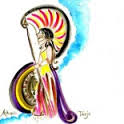1. Comics – each weekend, we would roll out of bed and fly to the stationer’s, first thing, to get our weekly dose of Beano or Dandy. The girly girls had Bunty, with a cut-out doll and her clothes on the back page. The position of the limbs and head was always slightly different, so clothes from one week would not fit the doll from another… I know! There were also Mandy, Tina, Jinty, Diana, Judy, and others. The more studious teens bought Look and Learn, or, later, Knowledge (which had better paper, but was not as good). Then there were the absolute nerds, who bought the magazines that had the words of popular songs (English or Italian versions) and learned them all by heart. The more hip bought Jackie.

2. Hikes – The Great Outside was a magnet, when there were no electronic devices to hypnotise young minds. Packed lunches, frozen soft drinks that melted as one travelled, and fruits and nuts…all these made for parties on the move. The sedentary version of this was either a picnic, when it was held in the open air, or a Bottle Party, when it was held in someone’s residence. The adult version was a pot-luck lunch or supper.
3. Penfriends – the more you had, the more bohemian and avant-garde you were considered. And if you could say a couple of words that Dominik from Austria or Akio from Japan taught you, it was even better. For the boys, of course, if the girl was a looker it gave them a couple of extra Brownie points. Ditto for the girls if the boy was handsome. Of course, it n ever entered our minds that the photos could have been of someone else, and Photoshop had not been invented yet.
4. Platform shoes – they gave us extra height, but less inches of boys to choose from, especially since during teen years, boys tend to be shorter than their female peers. Twisted ankles (and sometimes broken legs) were par for the course. Some of these shoes were plug ugly, and some were simply adult Mary Janes. You could not wear platforms of more than one inch (measured by a ruler) for school.

5. Rediffusion – Those who grew up with 24/7 radio find it hard to believe that the olden days local version came packaged in a Bakelite or wooden box with a grille at the front. Transmissions began at 6.00am, and went on till 11.00pm – and in some households the set was never switched off. There were two switches A (local) and B (English-speaking). The clanging of bells on the latter, on a Sunday morning, signalled the Tom Meijer Happy Station Show, from Radio Nederland (Hilversum).

6. Retreats – these days they are known as live-ins. Mostly single-sex, but, rarely, also “mixed”, these were held from Friday evenings to Sunday afternoons at retreat houses (these days even hotels are used). The idea was to remove youth from the temptations afforded by Carnival (Halloween was not even an issue back then), or to orchestrate socialisation opportunities during school holidays and / or long weekends. The schedules consisted of Mass, group meetings, talks, meals, and free time, during which one could catch up on reading and correspondence, do crafts, meditate, or talk with fellow ‘hermits’.
7. Sweetmeat Cigarettes – These were either bubble-gum or sickly sweet sticks, or soft chocolate covered with edible rice paper. The tip was red, so one could pretend to be smoking “like an adult”. The preferred bubble-gum, though, was Bubbly – a gob of lurid pink latex-like substance that could be blown into bubbles big enough to stick to the face and hair when they inevitably burst.

8. The Chalet – this used to be an outdoor restaurant / dolceria / restaurant / cafeteria on the Sliema front, run by the Axisa family. It fell to wrack and ruin, and became the ultimate challenge for macho men, and some women, to show their bravado by leaping off the roof into the sea below. Many injuries were reported, and despite padlocks and gates having been installed, these days some people are chancing their luck, and their lives there, again.

9. Thunderbirds – the originals were much better than the recent copies. The Tracy brothers marionettes, with the jerky movements, were named after Mercury Seven astronauts – Scott Carpenter, John Glenn, Virgil “Gus” Grissom, Gordon Cooper, and Alan Shepard. Lady Penelope operated from Creighton-Ward Mansion as British Agent for International Rescue. Stingray was the “marine” version of this series: the more fascinating female interest was 19-year-old Marina, daughter of Aphony, ruler of Pacifica, the underwater shell city. She was rescued by Troy Tempest and Phones from the evil underwater Sea Lord Titan.

10. Winner Soft Drinks – These came in lemonade, orange / tangerine, and cola flavours, and were delivered in old wooden crates that often smelled of damp. The logo was a horseshoe, under which there was a horse’s head. We also had Royal Crown Cola, and Kicks, which was, I suppose, a cheap imitation of Kick, which in turn was marketed as “The hard-core, psycho, nitro drink in a can!” We had Mirinda (which means admirable or wonderful in Esperanto), Teem, and Rodeo.












